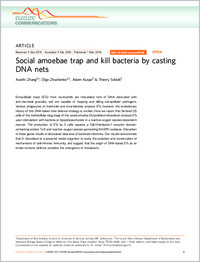Social amoebae trap and kill bacteria by casting DNA nets.
- Zhang X Department of Biochemistry, Science II, University of Geneva, Geneva 1211, Switzerland.
- Zhuchenko O Verna and Marrs McLean Department of Biochemistry and Molecular Biology, Baylor College of Medicine, One Baylor Plaza, Houston, Texas 77030-3498, USA.
- Kuspa A Verna and Marrs McLean Department of Biochemistry and Molecular Biology, Baylor College of Medicine, One Baylor Plaza, Houston, Texas 77030-3498, USA.
- Soldati T Department of Biochemistry, Science II, University of Geneva, Geneva 1211, Switzerland.
- 2016-03-02
Published in:
- Nature communications. - 2016
Bacteria
DNA
Dictyostelium
Extracellular Traps
Klebsiella pneumoniae
Microbial Viability
Pseudomonas aeruginosa
Reactive Oxygen Species
English
Extracellular traps (ETs) from neutrophils are reticulated nets of DNA decorated with anti-microbial granules, and are capable of trapping and killing extracellular pathogens. Various phagocytes of mammals and invertebrates produce ETs, however, the evolutionary history of this DNA-based host defence strategy is unclear. Here we report that Sentinel (S) cells of the multicellular slug stage of the social amoeba Dictyostelium discoideum produce ETs upon stimulation with bacteria or lipopolysaccharide in a reactive oxygen species-dependent manner. The production of ETs by S cells requires a Toll/Interleukin-1 receptor domain-containing protein TirA and reactive oxygen species-generating NADPH oxidases. Disruption of these genes results in decreased clearance of bacterial infections. Our results demonstrate that D. discoideum is a powerful model organism to study the evolution and conservation of mechanisms of cell-intrinsic immunity, and suggest that the origin of DNA-based ETs as an innate immune defence predates the emergence of metazoans.
- Language
-
- English
- Open access status
- gold
- Identifiers
-
- DOI 10.1038/ncomms10938
- PMID 26927887
- Persistent URL
- https://sonar.ch/global/documents/206259
Statistics
Document views: 22
File downloads:
- fulltext.pdf: 0
